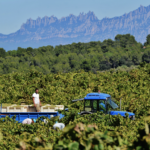
A decade ago, wine experts like Jancis Robinson said that the quality of Slovenian wines was hit or miss, but in the years since, the country has set off on a pathway to being one of the world’s most exciting wine regions.
Slovenia is a relatively young country, politically speaking — it only just gained independence from Yugoslavia in 1991. Before that, most wine-making operations had been the same since World War II — large cooperatives focused on low-quality, bulk wine production. These are likely the wines with “high acidity, severe tannins and lack of fruit…” Robinson described. From the late 1940s, Yugoslavia was a Socialist state marked with political repression and heavy industrialization, but with a strong influence of liberal intellectuals that not only stoked the fires of independence but created an important body of film, art and literature.
Historically, wine production in the regions around Slovenia pre-dates Roman rule—dating back to the Celtic and Illyrian tribes that planted vines for wine cultivation around the 5thCentury B.C.E. Wine production continued during the rule the Holy Roman Empire and was later controlled by the Catholic Church during the Middle Ages as part of the monastery system. From the 14thcentury to 1918, the region was under Hapsburg rule. This equates to both a long history of viniculture and cultural influences that are making a comeback today, as Slovenian winemakers are drawing not only on long-forgotten ancient traditions from the region but modern winemaking practices. Slovenia shares its borders with Italy, Austria, Hungary and Croatia (plus the Adriatic Sea) and takes influences on its cuisine and wine from each of them. As they leave industrialized winemaking behind, they’re approaching a new frontier they get to shape themselves.

In a country roughly the size of New Jersey, Slovenia has three major wine regions: Podravje/Drava, Primorska/Littoral, and Posavska/Lower Sava. Each are further divided into districts with different micro-climates and unique varietals. Touch down in Slovenia’s capital city, Ljubljana, and just a short drive later, you’ll be in the heart of Slovenian wine country.
Podravje
Podravje takes its name from its location in the Drava River Valley and is the largest of Slovenia’s wine regions, divided into the larger ŠtajerskaSlovenija with Prekmurje tucked into the northeastern corner. These are the official designations, though colloquially, the region is divided into seven districts. Ninety-five percent of the wines that come from the region are whites, in particular dessert and sparkling wines, which began production using the méthode champenoise in 1852.
Don’t Miss: Maribor is Slovenia’s second-largest city and the center of the region’s tourism. The Old Vine House is a museum of Slovenian wine history (with a tasting room) and is home to the world’s oldest vine, estimated to be some 450 years old. Vinag Wine Cellar is one of Europe’s oldest and holds more than 5 million liters of wine in tunnel s over a mile long. Tour company Find Eat Local runs a Drava river raft wine tasting among other wine-related tours.
Wineries to visit: Johannes Protner, a scenic winery with tasting room surrounded by rolling hills and known around the world for its wines. Vinogradi Horvat is a family-owned winery that’s been making wine for generations. Chateau Ramšak is not just a winery but a luxe glamping resort. Dveri Paxi is a former Benedictine monastery that has been producing wine for 800 years.

Primorska
Primorska is Slovenia’s developed and best-known wine region, and even though it’s smaller than Podravje in number of cultivated hectares, it still produces 30 percent more wine — some 25 million liters a year. The region has four districts. GoriškaBrda in the north (which borders the Friuli-Venezia Guilia in Italy); Vipava Valley further south, producing Merlot, Cabernet Sauvignon, Chardonnay, Sauvignon Blanc, Pinot Gris, Pinot Noir, Rebula , Refosco, and Friulano. Kras (Karst) sits along the Italian border near the city of Trieste and is known for a wine style called teran—a very dark, acidic red wine made from Refosco grapes. The Koper district along the Istrian peninsula Adriatic Coast is the country’s warmest wine region and grows primarily Refosco and Malvazija grapes. The region grows a number of other varietals, some of which are familiar, like Barbera, Cabernet Franc and Syrah, and others that aren’t, like Cipro, Vitovska Grganja, and Zelen. Known for its resemblance to Tuscany, Primorska has a strong Italian influence in wine styles, culture, cuisine, and architecture.
Don’t Miss: Erzetič Family Winery, in Višnjevik, Brda, produces wine using modern techniques (stainless steel vats) and ancient techniques like clay amphorae buried underground, which they’ve been doing since at least 1725. Movia Wines is owned by world-wide winemaking superstar Ales Kristancic. He creates natural wines, like Puro, a sparkling wine left on the lees before disgorging and Lunar, a natural orange wine aged in barrels underground for nine months.The Karst Wine Road connects dozens of small family-owned wineries (tip: call ahead if you want a tour and tasting) like Lisjak, one of the country’s best-known wineries (try the teran here). Stay at Hostel Kras.
Posavska
Posavska contains the districts of Bizeljsko Sremič, Dolenjska, and Bela Krajina and is the only wine-growing region in the country that produces more red wine than white (though not by much). Its three districts are Bizeljsko-Brežice, Lower Carniola and White Carniola. Bizeljsko-Brežice produces mostly sparkling wines and acidic whites made from the Rumeni Plavec grape. Lower Carniola produces wines of Cviček made from a blend of white and red wine grapes, most commonly Kraljevina and Žametovka. The White Carniola district isknown for its red wine made from Modra Frankinja and Rumeni Muškat. Other grapes found planted throughout The Lower Sava Valley include Beli Pinot, Cabernet Sauvignon, Chardonnay, Gamay, Modri Pinot, Neuburger, Ranina, Rdeča Zlahtnina, Renski Rizling, Šentlovrenka, Šipon, Sivi Pinot, Traminec, and Zweigelt. If you think that’s a mouthful, wait until you’ve actually sampled several at a wine tasting!
Don’t Miss: Rajhenburg Castle has a gallery dedicated to wine. The intersection of the Sava and Krka Rivers, Slovenia’s two longest rivers, is known as the Thermal Riviera. Terme Čatež Spa is the country’s largest hot springs resort. Consider staying a night at the Hotel Golf Grad Mokrice, located on the resort’s grounds—it’s a Medieval castle surrounded by a golf course (and is a little more than $100 a night). The area is dotted with castle and vineyards to explore.
So we wait to see what happens next.

Rebecca Treon is a Denver-based freelance food, travel, and lifestyles writer who has written for publications like 5280, DiningOut, American Bungalow, Reign, Denver Hotel, The Coastal Table, the Huffington Post, Tasting Table, Food 52, Time Out, BBC Travel, Livability, The Cape Cod Travel Guide, Edible Cape Cod,Edible Denver, Edible Lower Alabama, Alabama Journey, The Denver Post, and DRAFT magazine. She is the proud mother of two tiny globetrotters.



